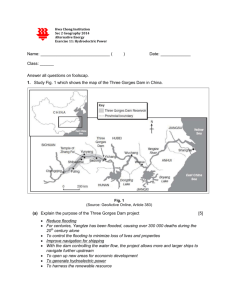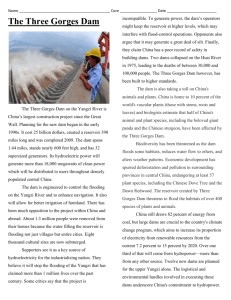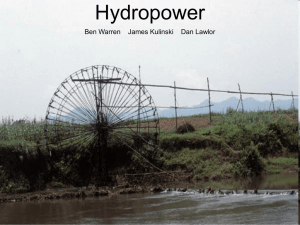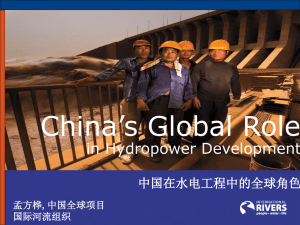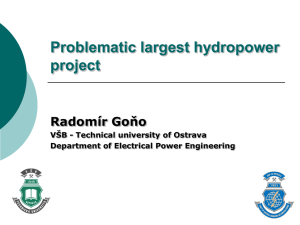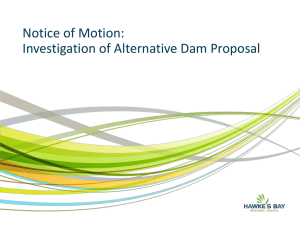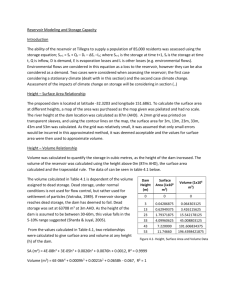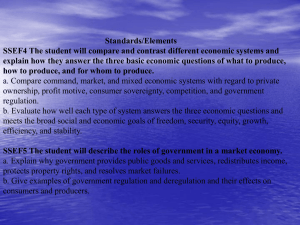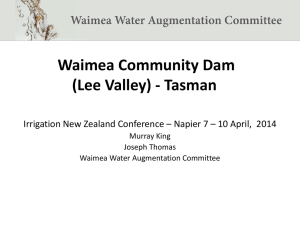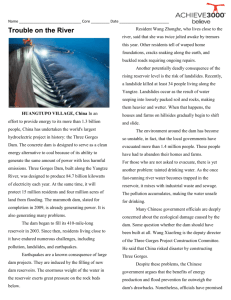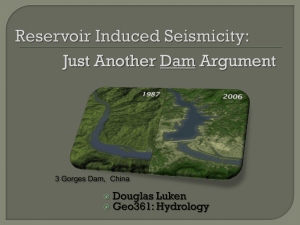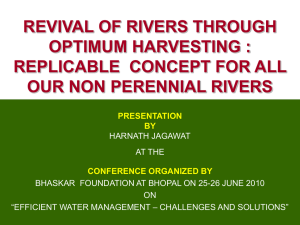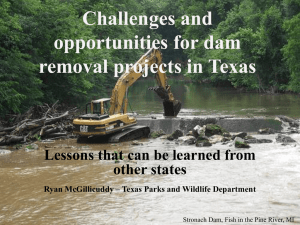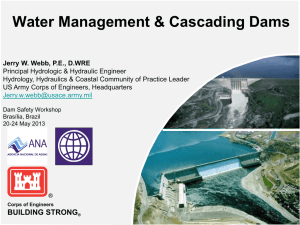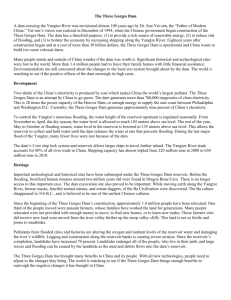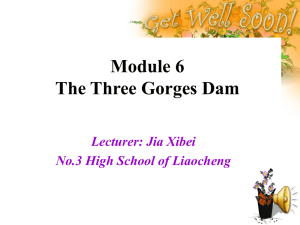Water.pol139.2010.wk.10
advertisement
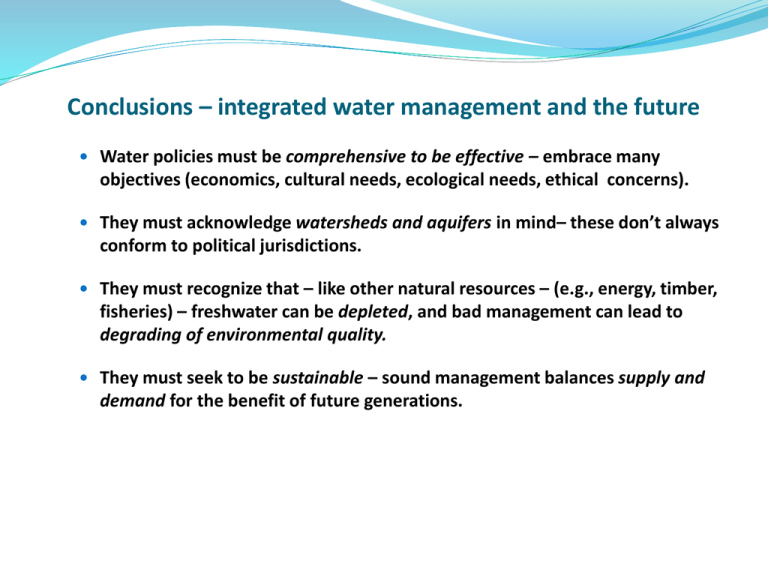
Conclusions – integrated water management and the future Water policies must be comprehensive to be effective – embrace many objectives (economics, cultural needs, ecological needs, ethical concerns). They must acknowledge watersheds and aquifers in mind– these don’t always conform to political jurisdictions. They must recognize that – like other natural resources – (e.g., energy, timber, fisheries) – freshwater can be depleted, and bad management can lead to degrading of environmental quality. They must seek to be sustainable – sound management balances supply and demand for the benefit of future generations. Reforming decision-making important to the future of water resource policy Bad decisions generally ignore alternatives to providing additional freshwater. Bad decisions ignore costs, adverse environmental impacts. Bad decisions ignore socially damaging consequences – e.g., need to relocate people. ------------------------------------------ Good decisions consider all viable options to supplying clean water– they try to evaluate and embrace emerging social and natural trends. Good decisions rely on good science that is not beholden to special interests. Good decisions embrace public concerns and public demands through allowing participation. Adaptive Management – making better decisions Goal – make and modify decisions in light of what we have learned about the impacts of previous decisions on natural & social systems. We should seek to learn from mistakes, make corrections. Challenge – no one is in a position to “preach” to others: all have made their share of bad decisions. Decisions should be: Modest in scope and impact. Scientifically sound, based on real-time monitoring. Reversible if failure evident – avoid structural measures if possible. Negotiate boundaries among science, policy, ethics – by planning ahead. Developing nation efforts to develop water resources – lessons for adaptive management Brazil – Itaipu Dam (1971-1984) China – Three Gorges Dam (1994-2005) Itaipu Dam as case study Itaipu Dam – under construction Itaipu Dam – Parana River Border of Brazil and Paraguay Major dam benefits World’s 2nd largest hydroelectric facility – 14,000 MW (as much as 9 nuclear plants). Provides 20% of Brazil’s and 94% of Paraguay’s power. Fostered strong political and economic cooperation between Brazil and Paraguay – agreed to joint construction, management, and operation – a bi-national commission manages the project and sells power. In recent years – some political friction over power sales: Paraguay wants to be able to re-sell surplus power anywhere it chooses; Brazil says no. Has encouraged foreign investment in and around the project – from Argentina, Italy, U.S. Major dam impacts Over 700 square km of old growth forests were destroyed – mostly on Paraguayan side of reservoir; over 4 million people relocated. Some plant species became extinct during construction (including a rare orchid). Adaptive measures? Through bi-national efforts, many endangered plant species and forests were salvaged - today, over 50 percent of what could have been lost in the region remains. Both governments undertook environmental planning to monitor and prevent further damage to flora and fauna. To minimize effects of reservoir flooding on the fauna of the region by catching animals and releasing them in biological reserves. A forest buffer/protective zone was established around the reservoir on the Brazilian side to avert further damage after project completed. Verdict? Uncertain – much damage was averted after the project was completed; but initial impacts may be irreversible. Three Gorges Dam as case study Three Gorges Dam – under construction Three Gorges Dam – 2008 Major dam benefits Goal: “Build up a power project to promote economic development, improve the local eco-environment, and benefit reservoir migrants.” By 2011 will be able to generate 22,500 MW of electricity (equivalent to 10-15 fossil or nuclear power plants). Flood control of Yangtze River virtually ensured – 1.5 million hectares of land, 15 million people protected from 100 year floods. Year-round navigation channel to Shanghai and East China Sea: growth from 9.5 – 60 million tons/cargo per year between 2003-08. Gaining experience to be used in other projects on Jinsha River, elsewhere in China. Major dam impacts 1.3 – 2 million people displaced; 13 cities, 140 towns, 1,350 villages inundated; 600 kilometers of river valley flooded, many archeological sites lost. Submergence of hundreds of factories, mines, waste dumps creating effluent, silt, industrial pollutants and rubbish in reservoir. Erosion of reservoir and downstream riverbanks causing landslides, threatening one of the world’s biggest fisheries in the East China Sea. Scientists estimate annual catches may be reduced by one million tons due to decline in fresh water and sediment reaching the sea. Project plagued by corruption, spiraling costs, technological problems, resettlement difficulties. Achieving Adaptive Management Manage by learning/modify through experience: Determine what impacts affect basin and surrounding region. Give stakeholders opportunity to envision different scenarios. Former was done at Itaipu, not Three Gorges – latter was not done in either case: decisions were centralized, non-participatory from outset. Make errors reversible: Emphasize non-structural solutions where applicable. Employ multi-purpose planning from outset (e.g., in-stream flow, allocation, water quality). In both cases, governments set out to dam a river for power, flood control – non-structural measures, smaller dams not considered. Mid-course corrections: Some correction at Itaipu; remains to be seen if damage at TG can be reversed. Public involvement – limited at both; public was not encouraged to identify concerns/acceptable solutions. There were protests/public dissent at TG. Conclusions & lessons Debate is continuing – particularly as new dams come “on-line” (e.g., Ethiopia, China, India). Dams create adverse environmental and social impacts that cannot be entirely mitigated! Are adverse impacts worth the benefits? Does flooding an “upstream” region generate benefits for people “downstream?” – is it worth it? This is a debate in Ethiopia today, for example, over Gilgel Gibe project. How else can the world get its water supply, electricity, and development needs met?

